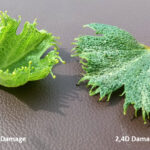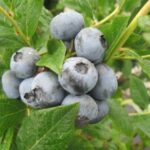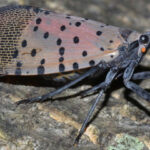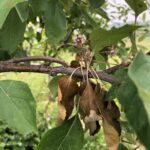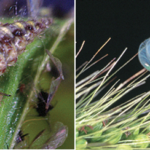Tree Fruit
Dear readers, I hope your spring and summer seasons are off to a great start! I haven’t heard much in the last couple of weeks about common fruit insect pests, so I thought I would highlight an interesting, but probably uncommon insect issue for most readers of Facts for Fancy Fruit: the round-headed apple tree[Read More…]
This is the time of year where we receive numerous reports of off-target herbicide exposure. Grapevines and fruit trees sensitive to growth regulator herbicides, including phenoxy, benzoic, and pyridine classes of compounds. 2,4-D and dicamba are the most common products, and they are used widely in corn and soybean production. Damage can range from minimal[Read More…]
Many readers will remember when a massive brood of periodical cicadas (Brood X) emerged throughout Indiana back in 2021. With their dark bodies, red eyes, and orange wings, these insects look like something straight out of the X-files, am I right?? There was lots of noise (male cicadas singing for the females!), lots of cast[Read More…]
Each spring, I know some of you may be using insect-pest monitoring traps for the first time, whether it’s in your orchard or backyard! It’s exciting to have these tools – they do the work for you, luring insects into a single location so you don’t have to guess when pests might appear. Moreover, you[Read More…]
Many of the pesticide products Indiana farmers use do not include specialty crops on the container’s label. These uses are often added through 24C Special Local Need (SLN) labels or supplemental labels, which can be difficult to locate. In response to this, the Office of the Indiana State Chemist created a “Pesticide Products- Special State[Read More…]
The Spotted Lanternfly is an invasive planthopper native to East Asia. It was introduced to the US in 2014 in Eastern Pennsylvania and has since spread to 13 other states including Indiana. The Spotted Lanternfly has 70+ host species including the invasive Tree of heaven (Alianthus altissma), grapes, apples, stone fruit, vegetables, hops, walnuts and[Read More…]
With last week’s thunderstorms and severe weather, fire blight continues to threaten crops: Hail can physically damage the tree and allow entry of the bacteria (Fig. 1) and secondary spread of the pathogen. Secondary spread of fire blight develops when stormy weather (especially hailstorms) occurs after the primary (blossom) infections. The amount of fire blight[Read More…]
There are so many different kinds of insects, but we often focus on the ones that cause damage (for obvious reasons). However, there are many beneficial, predatory insects you can be on the lookout for in your fruit plantings! These insects can be seen throughout the season, attacking aphids, mealybugs, caterpillars, mites, and even scale[Read More…]



